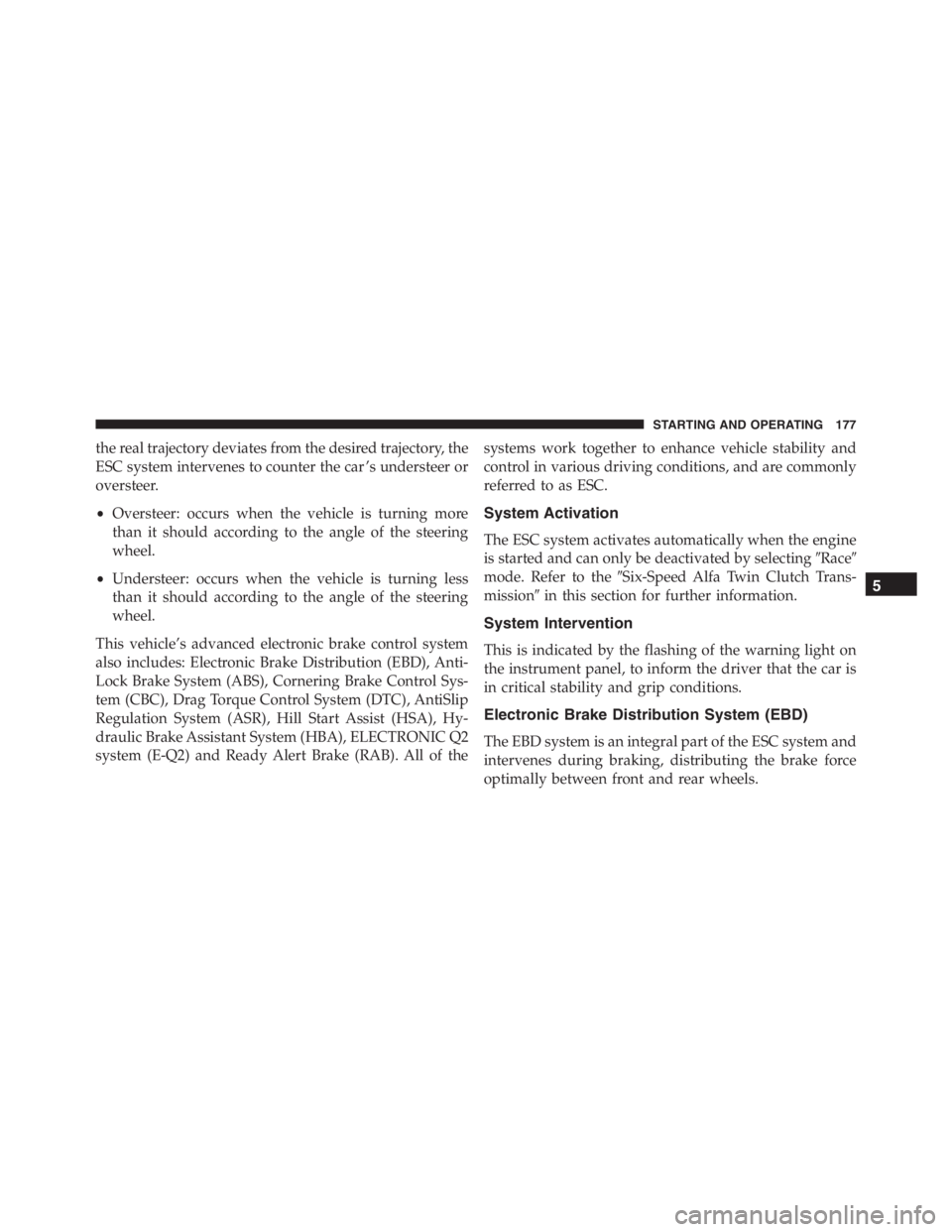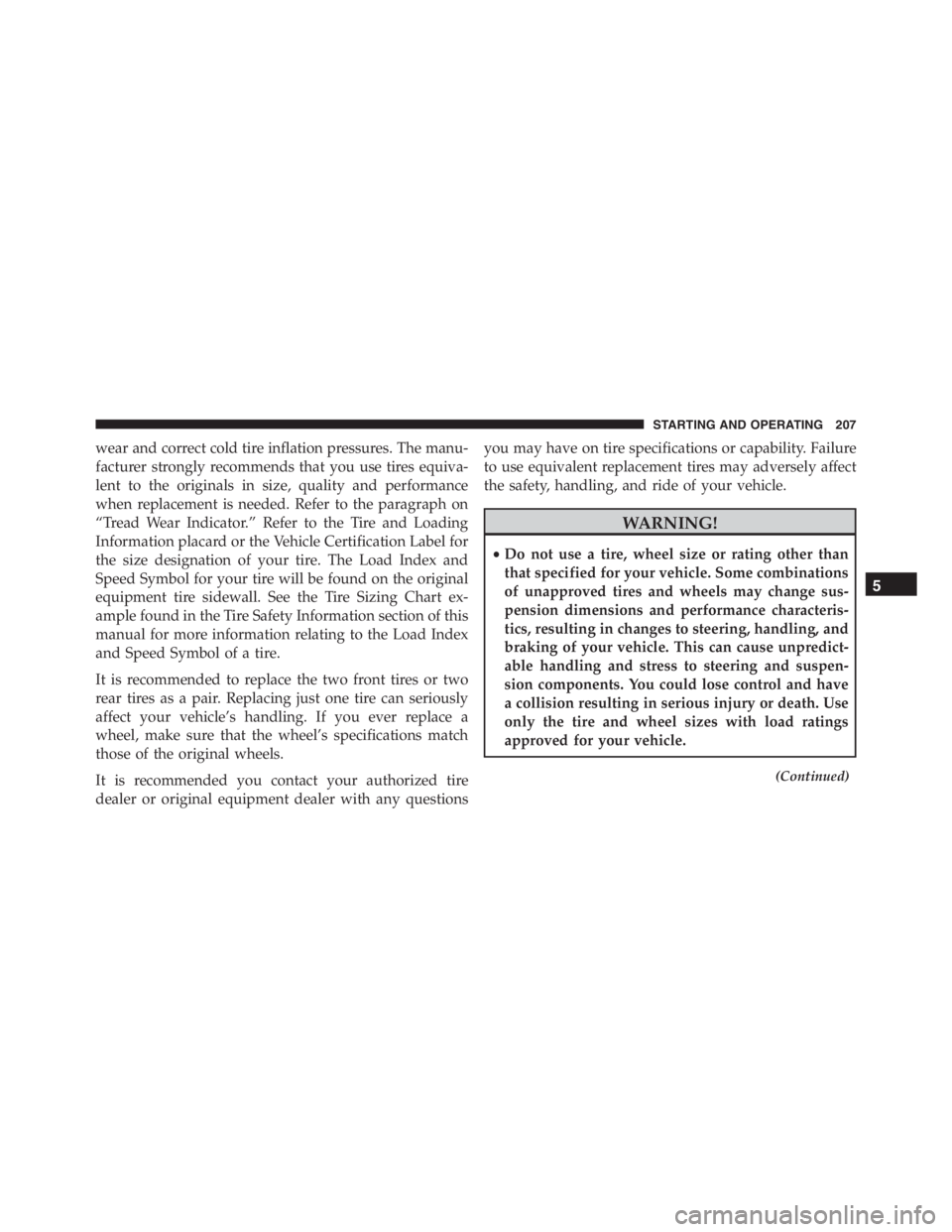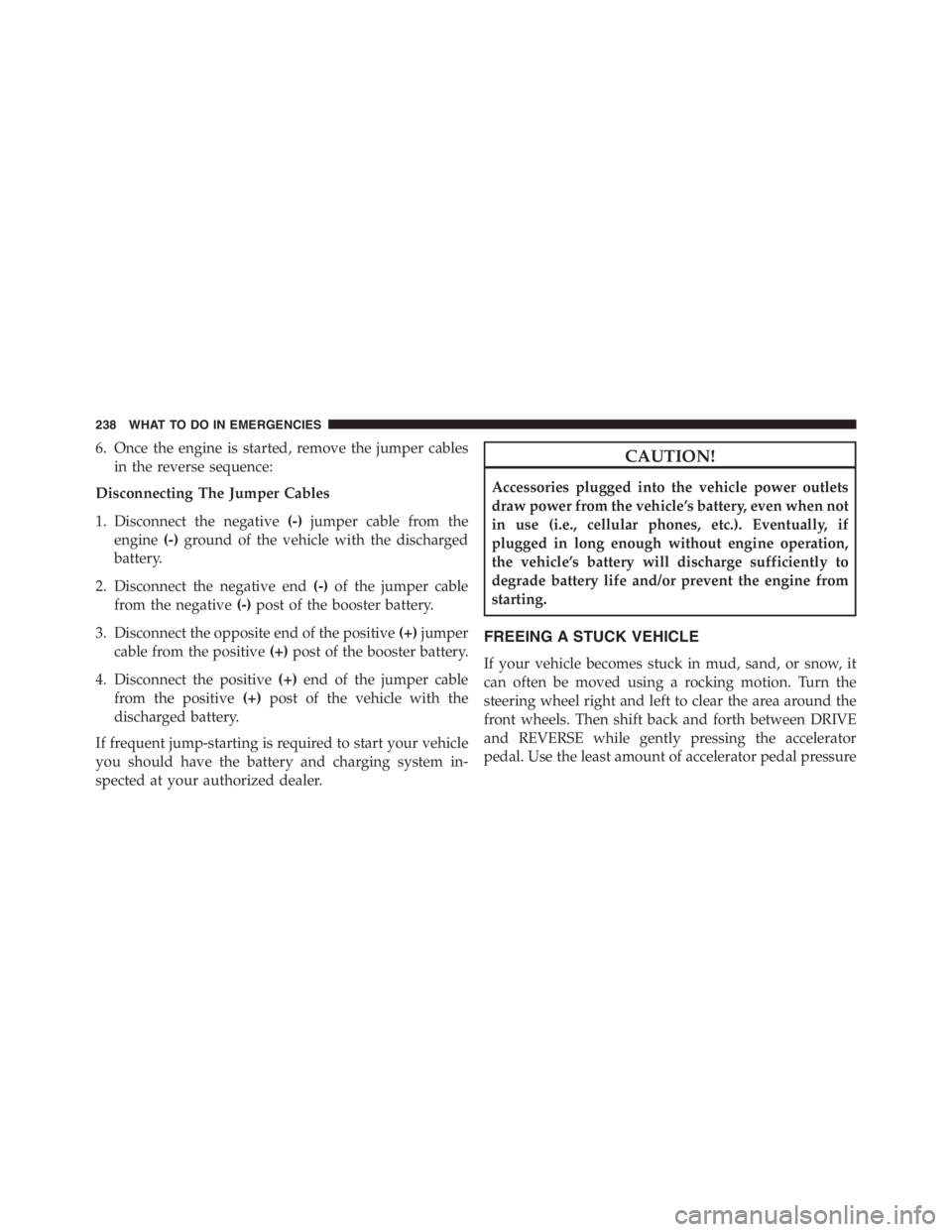Page 179 of 348

the real trajectory deviates from the desired trajectory, the
ESC system intervenes to counter the car ’s understeer or
oversteer.
•Oversteer: occurs when the vehicle is turning more
than it should according to the angle of the steering
wheel.
•Understeer: occurs when the vehicle is turning less
than it should according to the angle of the steering
wheel.
This vehicle’s advanced electronic brake control system
also includes: Electronic Brake Distribution (EBD), Anti-
Lock Brake System (ABS), Cornering Brake Control Sys-
tem (CBC), Drag Torque Control System (DTC), AntiSlip
Regulation System (ASR), Hill Start Assist (HSA), Hy-
draulic Brake Assistant System (HBA), ELECTRONIC Q2
system (E-Q2) and Ready Alert Brake (RAB). All of thesystems work together to enhance vehicle stability and
control in various driving conditions, and are commonly
referred to as ESC.
System Activation
The ESC system activates automatically when the engine
is started and can only be deactivated by selecting�Race�
mode. Refer to the�Six-Speed Alfa Twin Clutch Trans-
mission�in this section for further information.
System Intervention
This is indicated by the flashing of the warning light on
the instrument panel, to inform the driver that the car is
in critical stability and grip conditions.
Electronic Brake Distribution System (EBD)
The EBD system is an integral part of the ESC system and
intervenes during braking, distributing the brake force
optimally between front and rear wheels.
5
STARTING AND OPERATING 177
Page 183 of 348

WARNING!(Continued)
•Vehicle modifications, or failure to properly main-
tain your vehicle, may change the handling charac-
teristics of your vehicle, and may negatively affect
the performance of the ESC system. Changes to the
steering system, suspension, braking system, tire
type and size or wheel size may adversely affect
ESC performance. Improperly inflated and un-
evenly worn tires may also degrade ESC perfor-
mance. Any vehicle modification or poor vehicle
maintenance that reduces the effectiveness of the
ESC system can increase the risk of loss of vehicle
control, vehicle rollover, personal injury and death.
This is an integral part of the ESC system and automati-
cally operates in the event of one or both drive wheels
slipping, loss of grip on wet roads (hydroplaning) and
acceleration on slippery, snowy or icy roads, etc.Depending on the slipping conditions, two different
control systems are activated:
•If the slipping involves both drive wheels, the ASR
system intervenes, reducing the power transmitted by
the engine.
•If the slipping only involves one of the drive wheels, it
also intervenes automatically, braking the wheel that is
slipping.
System Intervention
This is indicated by the flashing of the warning light on
the instrument panel, to inform the driver that the car is
in critical stability and grip conditions.
5
STARTING AND OPERATING 181
Page 209 of 348

wear and correct cold tire inflation pressures. The manu-
facturer strongly recommends that you use tires equiva-
lent to the originals in size, quality and performance
when replacement is needed. Refer to the paragraph on
“Tread Wear Indicator.” Refer to the Tire and Loading
Information placard or the Vehicle Certification Label for
the size designation of your tire. The Load Index and
Speed Symbol for your tire will be found on the original
equipment tire sidewall. See the Tire Sizing Chart ex-
ample found in the Tire Safety Information section of this
manual for more information relating to the Load Index
and Speed Symbol of a tire.
It is recommended to replace the two front tires or two
rear tires as a pair. Replacing just one tire can seriously
affect your vehicle’s handling. If you ever replace a
wheel, make sure that the wheel’s specifications match
those of the original wheels.
It is recommended you contact your authorized tire
dealer or original equipment dealer with any questionsyou may have on tire specifications or capability. Failure
to use equivalent replacement tires may adversely affect
the safety, handling, and ride of your vehicle.
WARNING!
•Do not use a tire, wheel size or rating other than
that specified for your vehicle. Some combinations
of unapproved tires and wheels may change sus-
pension dimensions and performance characteris-
tics, resulting in changes to steering, handling, and
braking of your vehicle. This can cause unpredict-
able handling and stress to steering and suspen-
sion components. You could lose control and have
a collision resulting in serious injury or death. Use
only the tire and wheel sizes with load ratings
approved for your vehicle.
(Continued)
5
STARTING AND OPERATING 207
Page 240 of 348

6. Once the engine is started, remove the jumper cables
in the reverse sequence:
Disconnecting The Jumper Cables
1. Disconnect the negative(-)jumper cable from the
engine(-)ground of the vehicle with the discharged
battery.
2. Disconnect the negative end(-)of the jumper cable
from the negative(-)post of the booster battery.
3. Disconnect the opposite end of the positive(+)jumper
cable from the positive(+)post of the booster battery.
4. Disconnect the positive(+)end of the jumper cable
from the positive(+)post of the vehicle with the
discharged battery.
If frequent jump-starting is required to start your vehicle
you should have the battery and charging system in-
spected at your authorized dealer.CAUTION!
Accessories plugged into the vehicle power outlets
draw power from the vehicle’s battery, even when not
in use (i.e., cellular phones, etc.). Eventually, if
plugged in long enough without engine operation,
the vehicle’s battery will discharge sufficiently to
degrade battery life and/or prevent the engine from
starting.
FREEING A STUCK VEHICLE
If your vehicle becomes stuck in mud, sand, or snow, it
can often be moved using a rocking motion. Turn the
steering wheel right and left to clear the area around the
front wheels. Then shift back and forth between DRIVE
and REVERSE while gently pressing the accelerator
pedal. Use the least amount of accelerator pedal pressure
238 WHAT TO DO IN EMERGENCIES
Page 297 of 348
Side Lights/Daytime Running Lights (DRL)
These are LEDs. For the replacement, contact the your
authorized dealer.
Low/High Beam Bi-Halogen Headlights
To change the bulb, proceed as follows:
1. Turn the steering wheel completely.
2. Open the protective flap by rotating the screw.
1 — Direction Indicator Bulb Protective Flap
2 — Headlamp Bulb Protective Flap
7
MAINTAINING YOUR VEHICLE 295
Page 298 of 348
3. Remove the electric connector (1) and then rotate the
bulb holder (2) clockwise and remove it.4. Extract the bulb and replace it.
5. Refit the new bulb, making sure that it is locked
correctly, and reconnect the electrical connector.
6. Close the protective flap.
Low/High Beam HID & LED Headlights
For the replacement, contact the your authorized dealer.
Direction Indicators
Front:
1. Turn the steering wheel completely.
2. Open the protective flap by rotating the screw.
1 — Electrical Connector
2 — Bulb Holder 296 MAINTAINING YOUR VEHICLE
Page 344 of 348

Snow Tires..............................201
Spare Tire...............................203
Spark Plugs.............................307
Speed Control (Cruise Control)................93
Starting................................154
Automatic Transmission..................154
Cold Weather..........................155
Engine Fails to Start.....................155
Steering
Column Lock...........................92
Tilt Column............................92
Wheel, Tilt.............................92
Storage................................292
Storage, Vehicle...........................292
Storing Your Vehicle.......................292
Stuck, Freeing............................238
Telescoping Steering Column..................92
Tilt Steering Column........................92Tire and Loading Information Placard...........191
Tire Markings............................184
Tires...................................72
Aging (Life of Tires).....................206
Air Pressure...........................196
Chains...............................208
Compact Spare.........................203
General Information.....................196
High Speed...........................199
Inflation Pressures.......................197
Life of Tires...........................206
Load Capacity.........................191
Pressure Monitor System (TPMS)............210
Pressure Warning Light...................112
Quality Grading........................327
Radial...............................199
Replacement...........................206
Rotation..............................209
Safety...............................184
342 INDEX
Page:
< prev 1-8 9-16 17-24